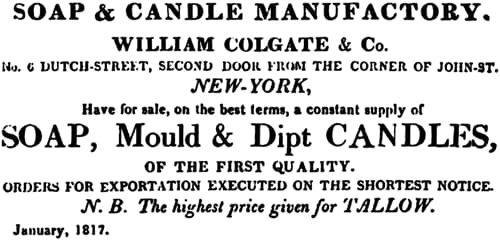#Colgate #History #Patents #Illustrated #Timeline
.
1806
William Colgate founded his business in New York. The warehouse premises were located at 6 Dutch Street, NY. The firm was involved in the manufacturing of soap and candles. It may seem a little strange to us but their range of soap included brown soap, as well as pale coloured soap. They also offered fancy soaps which were fashioned into unusual shapes.
1807
William Colgate formed a partnership with Francis Smith. The firm then became known as Smith and Colgate.
1813
Colgate bought out Francis Smith’s share of the business and went into partnership with his brother, Bowles Colgate until 1844. The business was now styled as William Colgate & Company. The company was now the largest manufacturer of perfumes in America.
WILLIAM COLGATE & CO. ADVERTISEMENT 1817
1817
The advertising copy welcomes orders which are needed urgently. Even clients requiring goods for export were promised –
ORDERS FOR EXPORTATION EXECUTED ON THE SHORTEST NOTICE.
The company offered –
The highest price given for TALLOW.
Tallow is animal fat.
You may wonder if 21st century cosmetic companies still use animal fat. The answer is “yes”. Vegan soaps are made by Beauty Without Cruelty and a few other brands but many soaps contain animal fat. You may like to research whether your favourite soap comprises animal products and whether the company uses animals for research.
1847
By 1847 the company was so successful that a much larger factory was required and so the soap-making plant was moved to New Jersey.
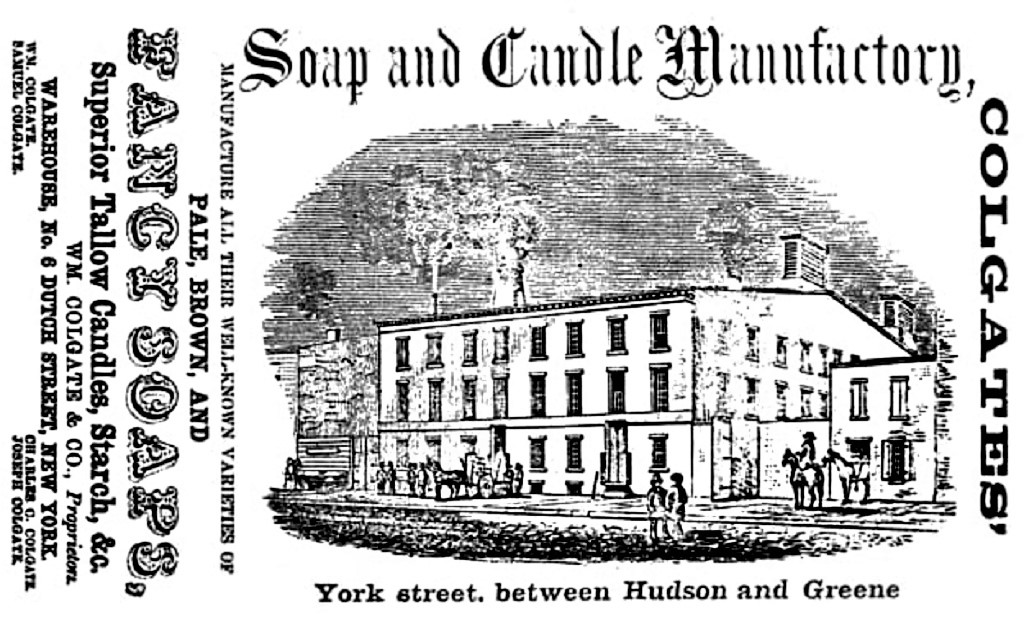
1854 ADVERTISEMENT
1854
Advertisements are such a good source of information.
The one above lists the proprietors as –
W. M. COLGATE
CHARLES G. COLGATE
SAMUEL COLGATE
&
JOSEPH COLGATE
1857
On March 25 1857 William Colgate passed away. He was laid to rest in Greenwood Cemetery, Brooklyn, New York.
1858
Following the founder’s passing Bowles Colgate’s son, Charles Carrol Colgate and William Colgate’s son, Samuel Colgate, became partners and the firm was reorganised as Colgate & Company.
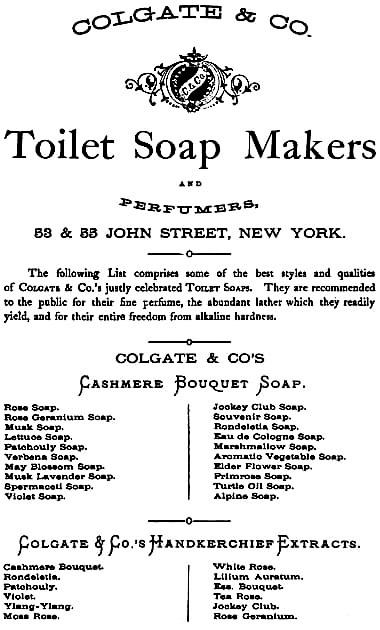
1872 ADVERTISEMENT
1872
The stylish advertisement shown above lists imaginatively fragranced soaps and handkerchief extracts. During this and the previous centuries it was customary for gloves and handkerchiefs to be dabbed in perfume.
Late 1800s
As you can see from the advertisements the Colgate range included much more than soap and candles. Toothpaste and talcum powder were also manufactured by this firm which also formulated perfumes to scent their cosmetics, especially their soap. Perfumes were also sold in luxurious scent bottles.
1900s
By the 1900s Colgate dominated the American cosmetics market.
1901
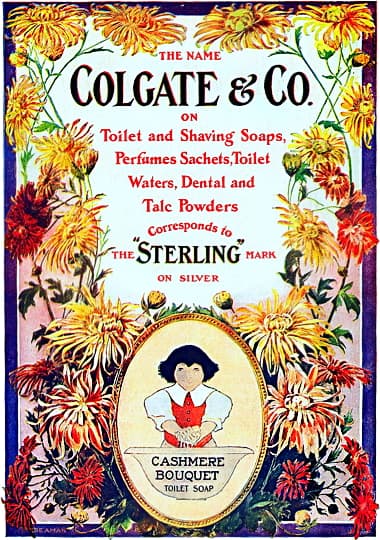
A COLOURFUL ADVERTISEMENT C.1901
1902
In this year George J. Adams invented a bottle closure for Colgate & Co. of the type which we see fitted in our talcum powder containers.
A summary of this invention follows:
SPECIFICATION forming part of Letters Patent No. 709,292, dated September 16, 1902.
Application filed February 27, 1902. Serial No. 95,854. (No model.) To all whom it may concern:
Be it known that I, GEORGE J. ADAMS, a citizen of the United States, and a resident of the city of New York, borough of Brooklyn, in the county of Kings and State of New York, have invented a new and Improved Bottle-Closure, of which the following is a full, complete and exact description.
This invention relates to improvements in closures or stoppers for packages containing toilet powder or the like and of that class having two parts provided with outlet-openings and arranged to rotate one part relatively to the other, so as to cause a register of the openings or to close the same; and the object is to provide a closure of this type in which the two perforated parts will be automatically held close together at all times, thus preventing an accumulation of powder between the parts.
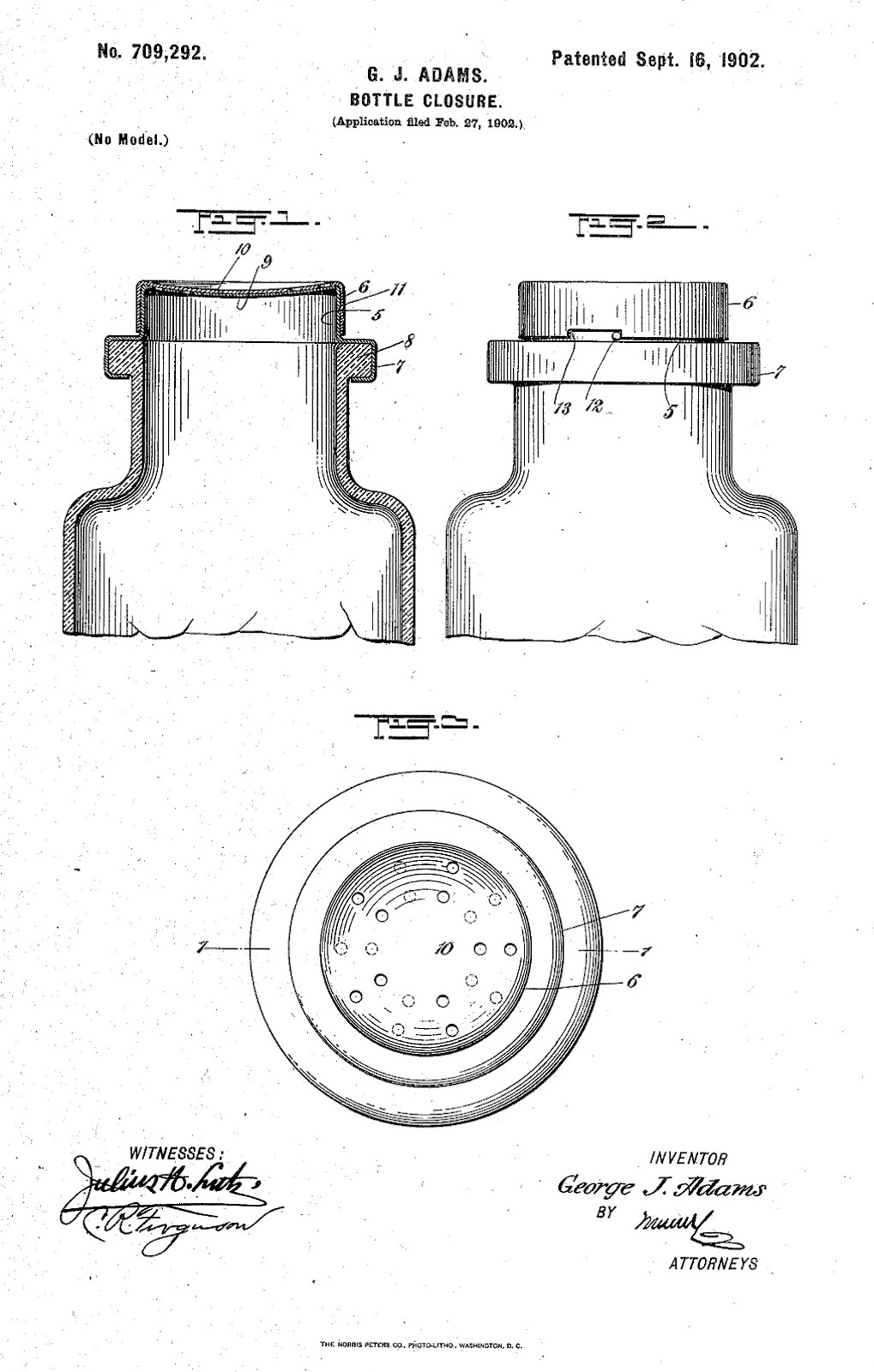
PATENT 709292
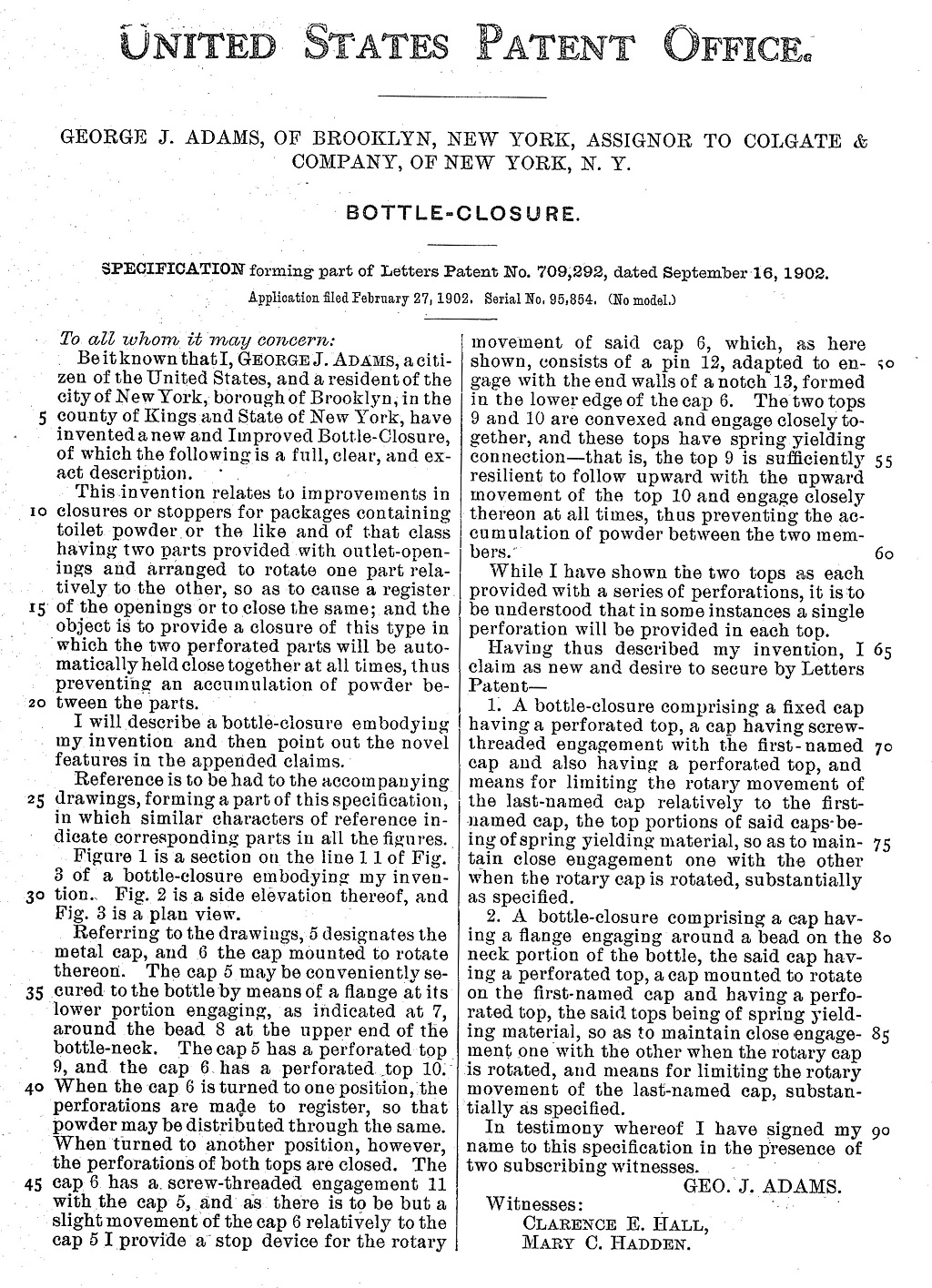
PATENT 709292
1906
In this year a patent application for a cake of soap was accepted.
Henry G. Pepino, describes his invention as:
My invention relates to soap for saving purposes, and particularly to the form of the cake specifically for use in a shaving mug.
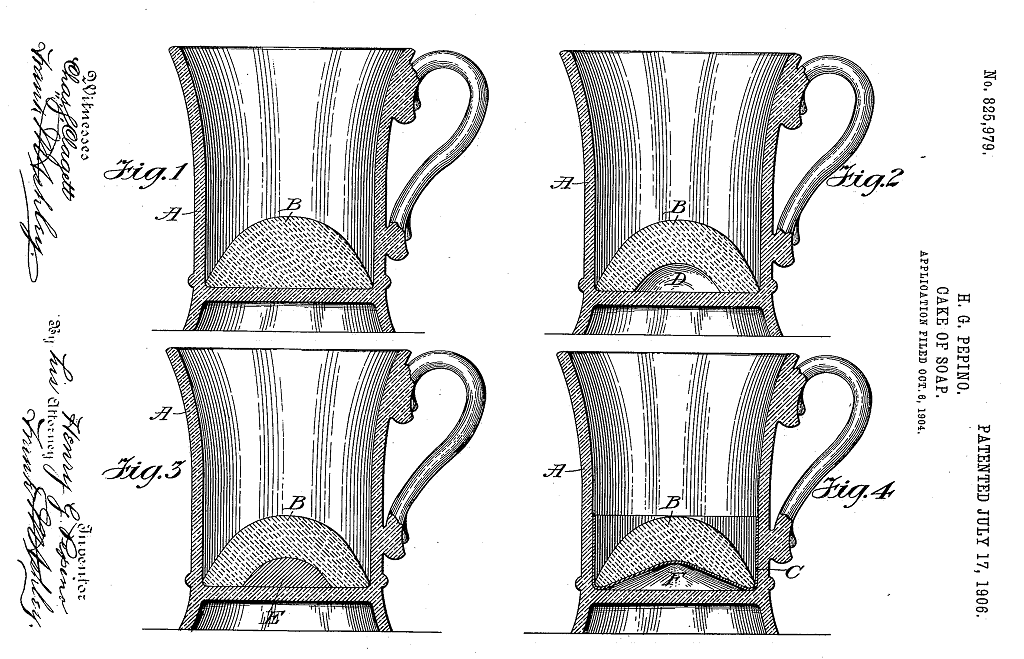
PATENT 825979
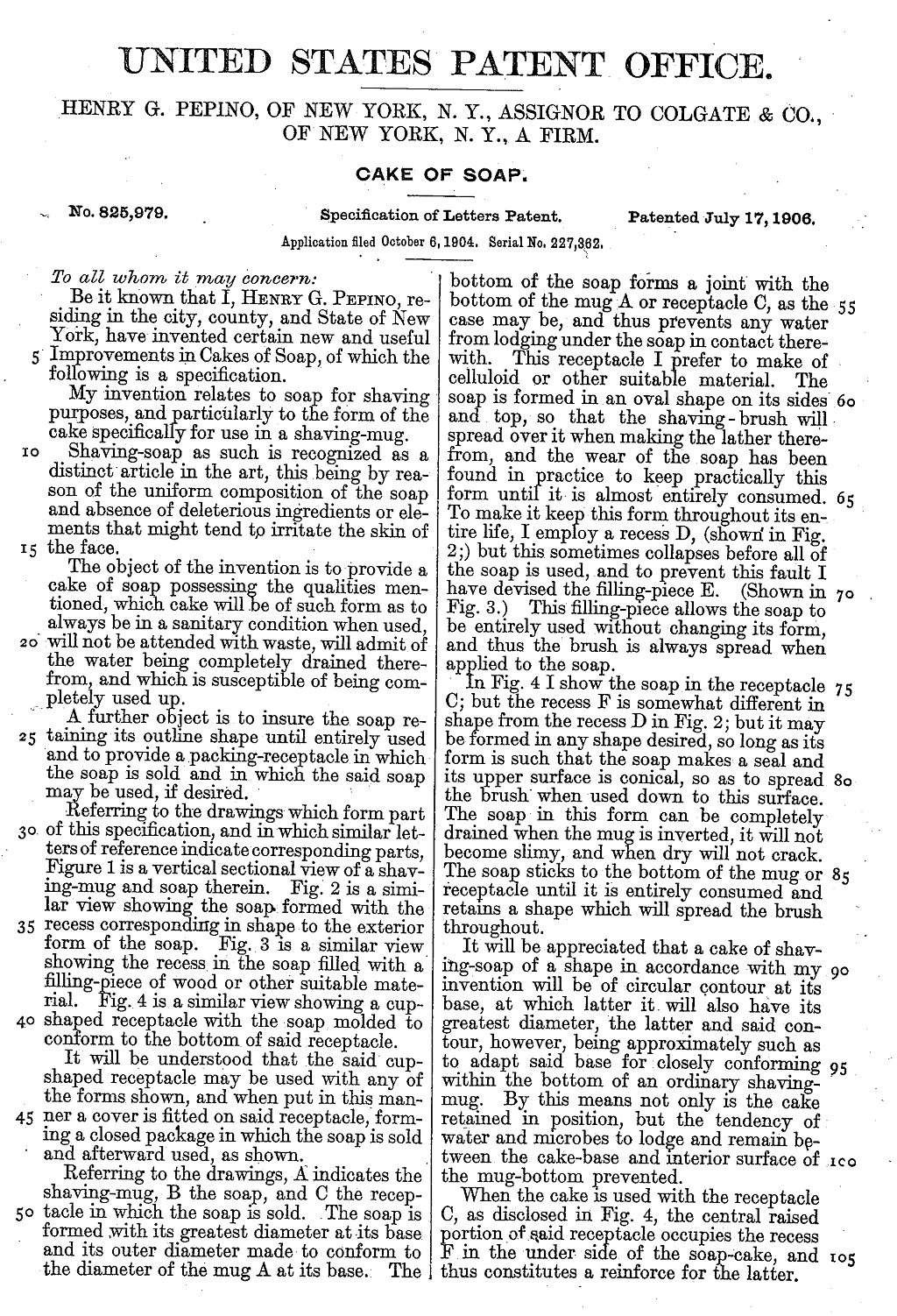
PATENT 825979
1909
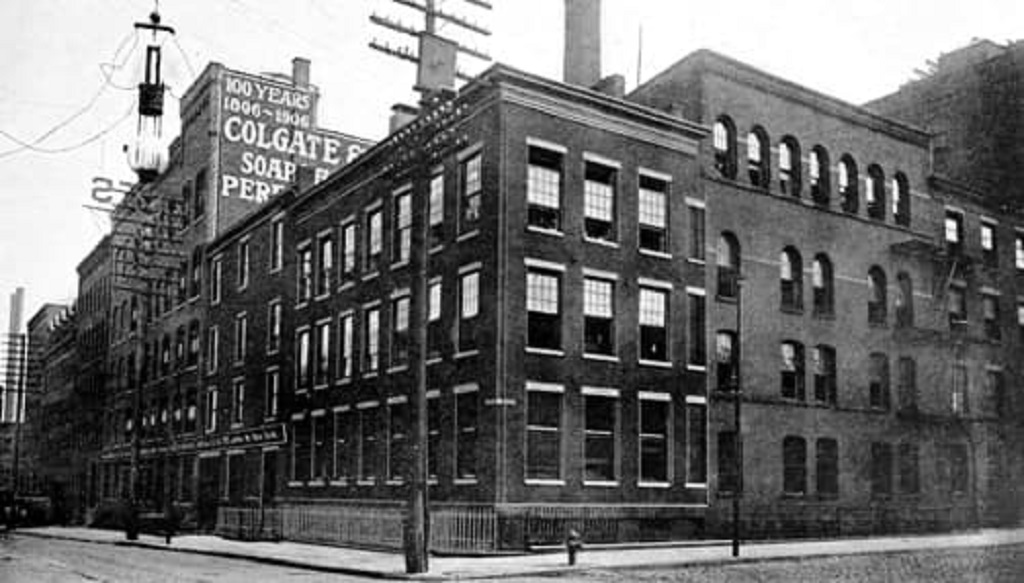
NEW JERSEY COLGATE FACTORY C.1909
1914
Colgate established its first international subsidiary in Canada c.1914.
1918
The Canadian manufacturing premises were located at 8 St Helens Street, Montreal c.1918.
1924
On September 24 1924 the patent application submitted by Samuel Bayard Colgate and Martin Hill Ittner, assignors to Colgate & Company, was accepted.
Their description of the invention:
This invention relates to collapsible tubes commonly used for containing plastic or pasty materials which are to be discharged in small quantities from time to time.
More specifically the invention is directed to the provision of a tube with a discharge nozzle which has an improved closure cap by which the orifice may be sealed so as to prevent contamination or accidental loss of the contents.
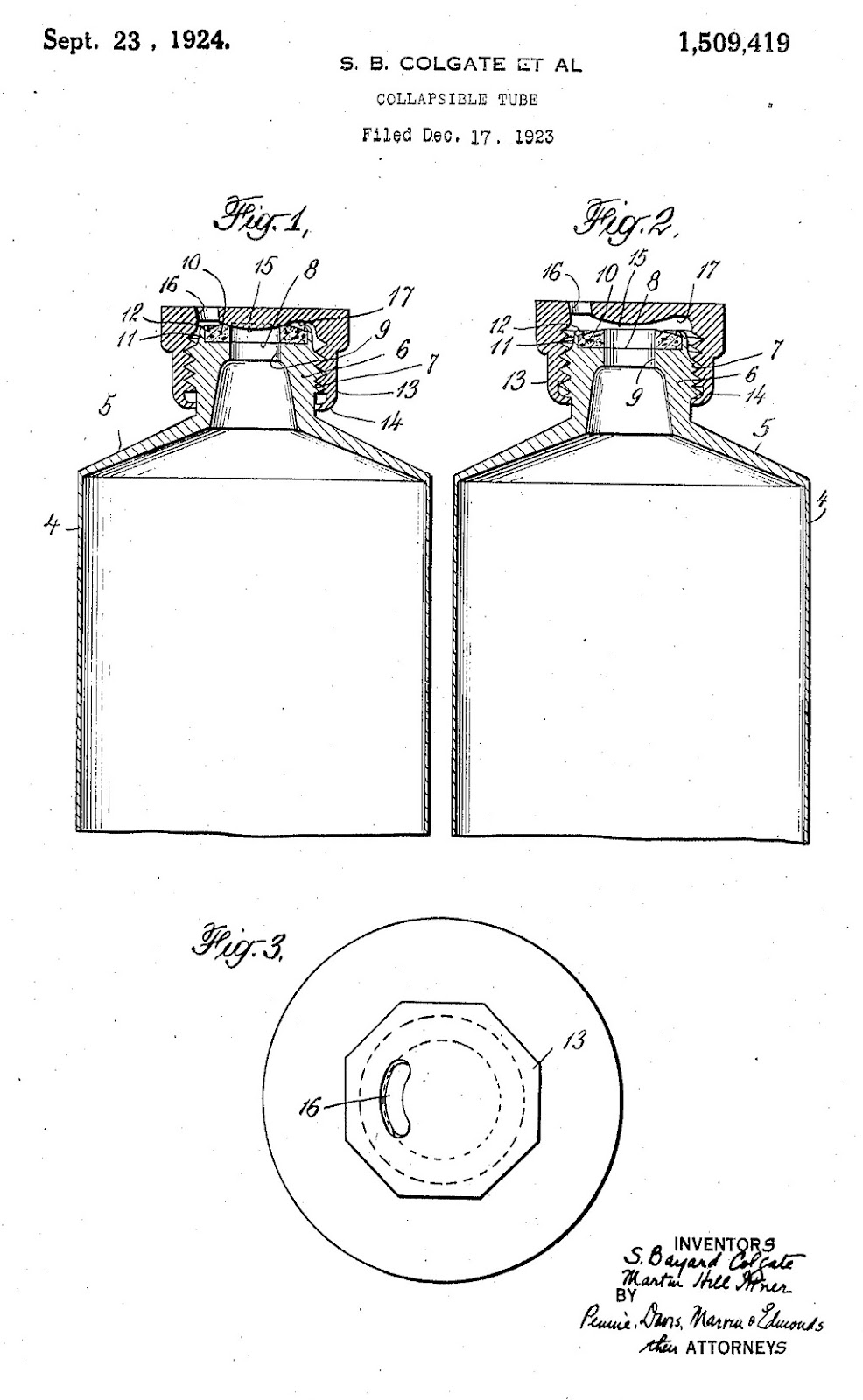 PATENT 1509419
PATENT 1509419
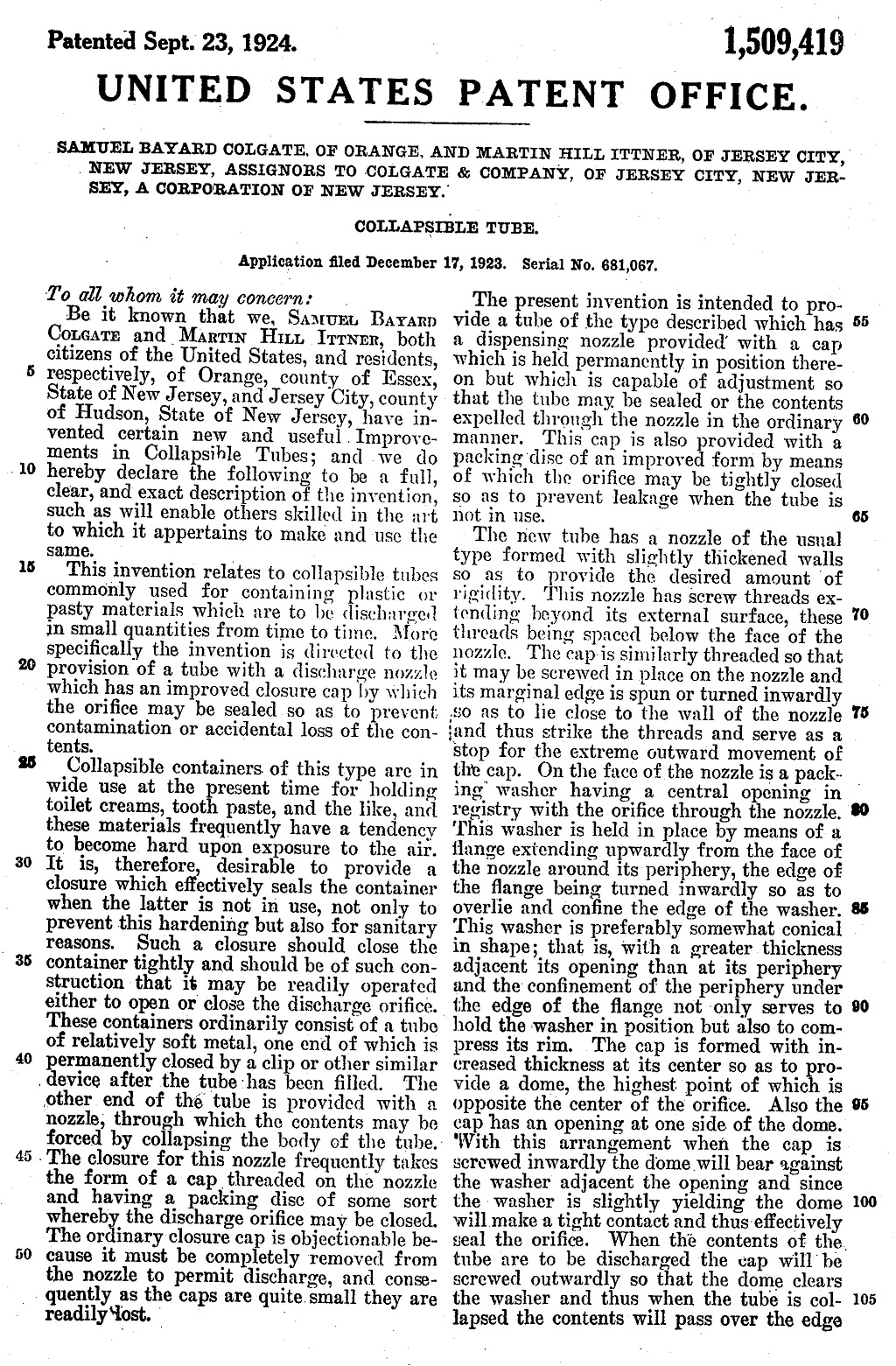
PATENT 1509419
1927
The Pompeian Manufacturing Company was bought out by Colgate.
1928
The company launched a new perfume which they named Seventeen. They trademarked this brand name and in the same year face powder, rouge and other facial preparations were added to this line of cosmetics. The company also offered high end compact cases to house their facial preparations.
Colgate merged with Palmolive-Peet just before the Wall Street Crash in 1929
1929
The Great Depression followed the Wall Street Crash.
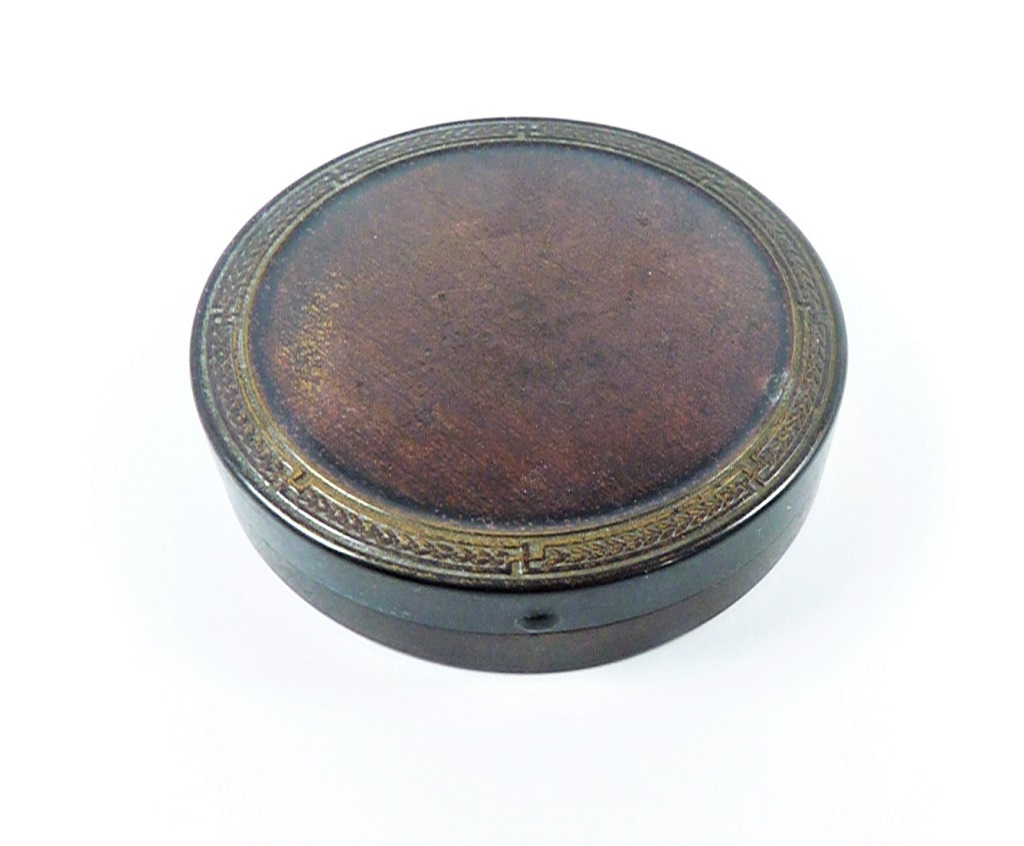
This is such a beauty & ideal as a film prop too. The whole exterior case is fine enamel. The lid is decorated with the classic laurel leaves in a circular band.
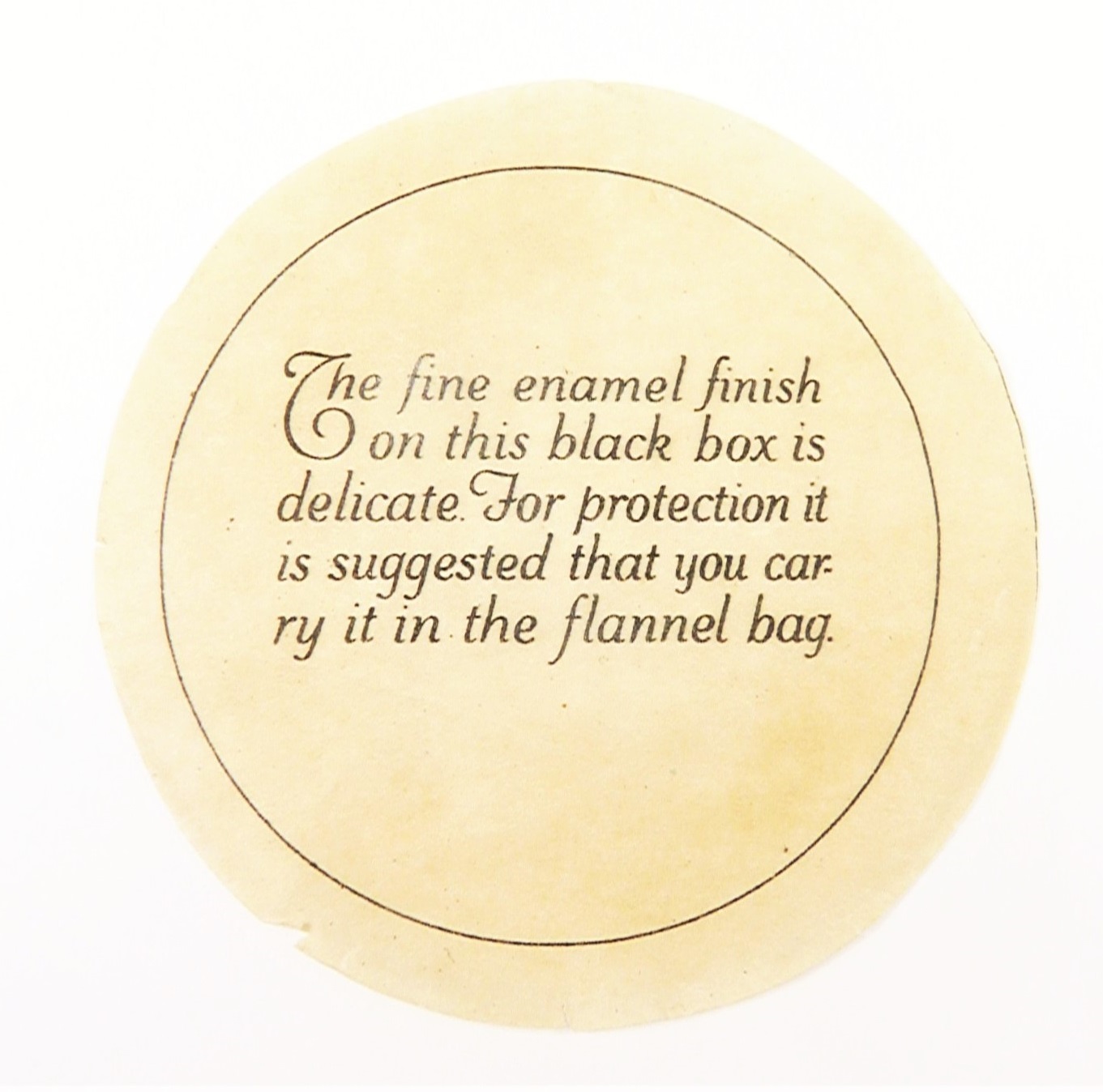
ORIGINAL INSTRUCTION LEAFLET
As we can see from the original instruction leaflet this compact would have been black when it was first manufactured in the 1920s.
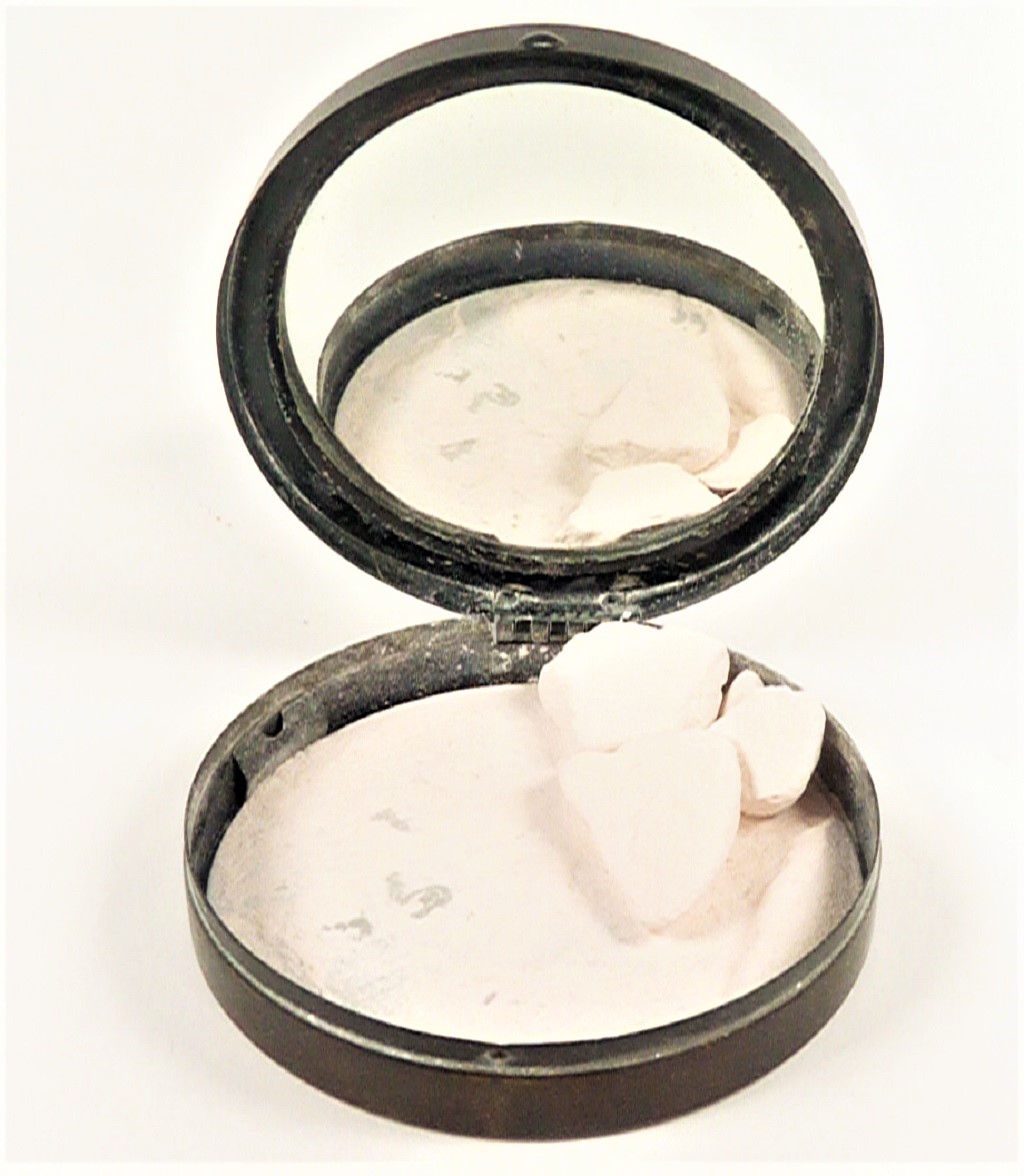
ORIGINAL VERY PALE FACE POWDER
The antique powder plate is still in place & so is a certain amount of the very pale pink powder. The image above shows one of the two metal clips holding the face powder plate in place. This powder plate is removable.
This vanity is made all the more charming by the presence of the original high quality golden silk & lambs wool puff, which is in superb condition & the instruction leaflets too.
The compact is signed:
COLGATE & CO. NEW YORK U.S.A.
View our wonderful collection of powder compacts.
Sources:
Colgate
Wikipedia
Cosmetics & Skin

